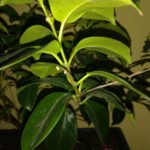I have attached 2 photos. First, a closeup of the leaves and second, the whole plant which, I presume, is a hibiscus vine. When I inherited Mr. Hibiscus, he was root bound, terribly tangled and very thirsty, but had a few blooms. I recently repotted him in good quality indoor mix with plenty of drainage rocks below, fed him some Miracle Gro and provided a sturdy lattice for him to climb. He sits facing a southwesterly window. When there is sunshine in Toronto at this time of year, he gets plenty! Since repotting, 5 or 6 leaves each week have turned yellow and dropped off, as shown in the first photo. With your help, please, I sincerely hope we can save him, if you wouldn’t mind opining about potential problems or sicknesses.


Hello and thank you for your question. Based on the photos you provided, it appears your plant is not a hibiscus but, rather, a mandevilla (Mandevilla spp.). It is a tropical vine that can be grown outdoors in the summer and brought indoors in the fall, before temperatures dip below 10°C. It can also be grown indoors year-round as a houseplant. In either case, it prefers bright indirect light or filtered sunlight. When brought indoors for the winter, the plant will naturally lose some leaves as it acclimates to a cooler and dryer environment. Continued yellowing and loss of leaves may be caused by over- or under-watering and/or pests.
Mandevilla requires less frequent watering in the winter, when growth slows and temperatures are on the cooler side, so be sure to let the soil dry out somewhat between waterings. Push your finger about an inch into the soil to check for moisture, and water only if dry. You do not need to fertilize during the winter.
Check your mandevilla for pests, especially if the plant was grown outdoors at any point. Insects such as mealybugs, scale and spider mites may be lurking on the underside of leaves and in the joints between the stems and leaves. They puncture leaves to draw out the sap, which can cause holes, introduce fungal disease and, ultimately, cause the leaves to yellow and drop. If you detect any such insects, treat the plant with an appropriate insecticidal soap, which you can purchase at most garden and home improvement centres.
For more information on caring for your mandevilla, please visit the following sites:
Mandevilla (by Clemson Cooperative Extension)
Winter Care for Tropical Bloomers (by University of Illinois Extension)

